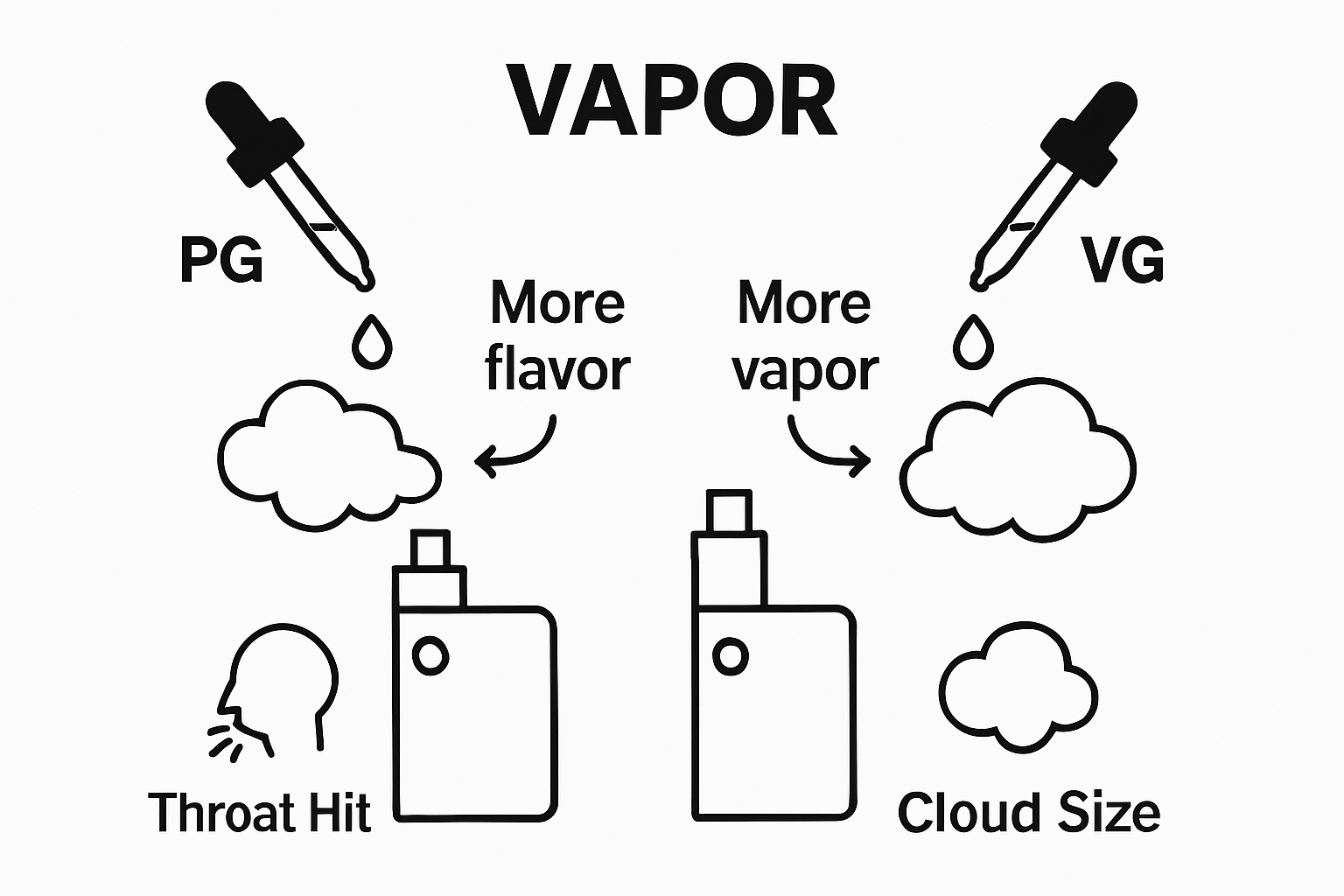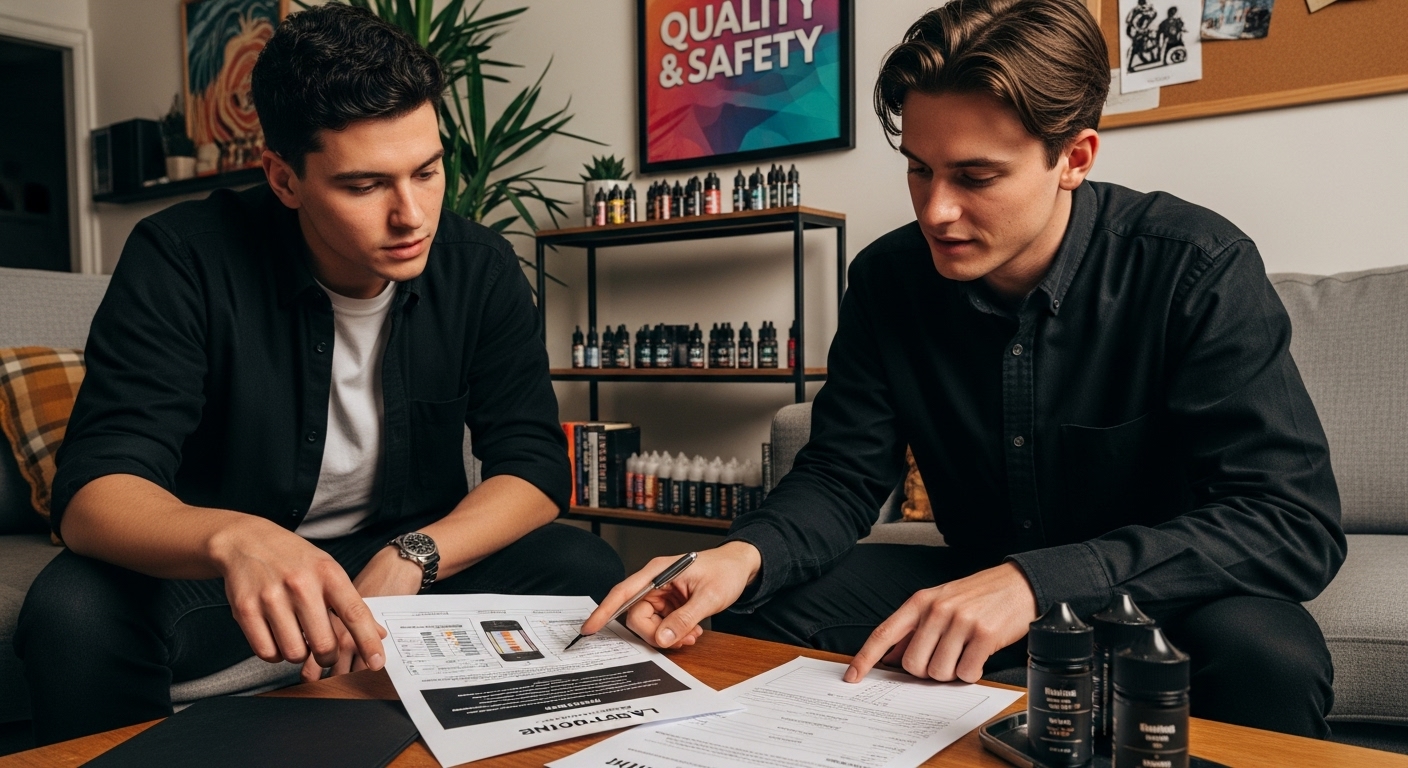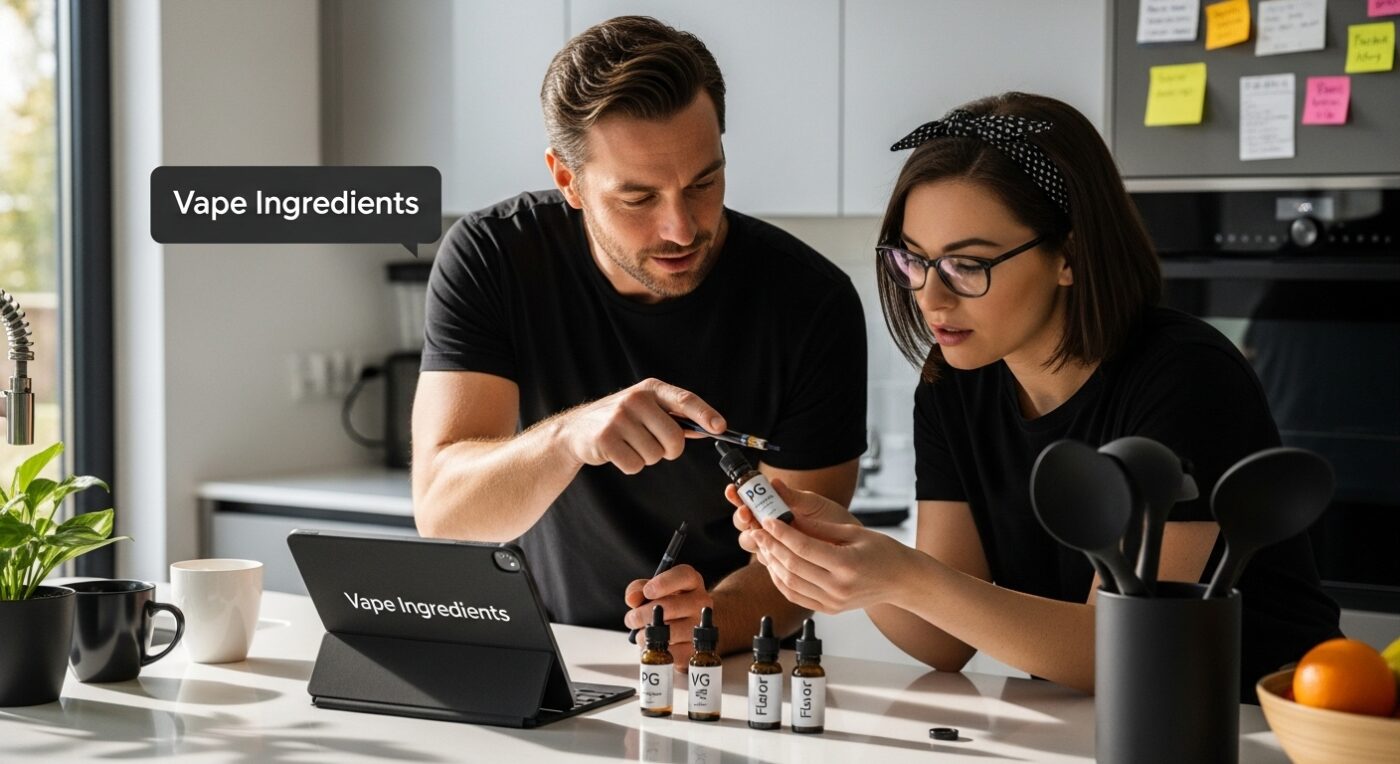Blog
What Are Vape Ingredients? Understanding Their Components
Vape ingredients go far beyond simple flavor and smoke. The core chemicals inside most vape liquids are carefully mixed and can include flavoring agents that make up just 1 to 4 percent of the liquid but completely transform the sensory experience. Many people think these products are mostly just propylene glycol and vegetable glycerin. The real surprise is that each ingredient—no matter how small—can play a major role in both taste and how your body responds to every puff.
Table of Contents
- Understanding The Basic Components Of Vape Ingredients
- The Role Of Propylene Glycol And Vegetable Glycerin In Vaping
- Flavoring Agents In Vape Products: What You Need To Know
- Understanding Cannabinoids And Terpenes In Vape Oils
- The Importance Of Quality And Safety In Vape Ingredients
Quick Summary
| Takeaway | Explanation |
|---|---|
| Vape ingredients are diverse and complex. | Vape products consist of propylene glycol, vegetable glycerin, flavorings, and active compounds like nicotine or THC. |
| Propylene Glycol and Vegetable Glycerin vary in function. | PG is a thinner liquid for sharper taste, while VG produces denser vapor and a smoother throat hit. |
| Flavoring agents greatly enhance vaping experiences. | These compounds mimic various flavors and textures, significantly impacting the overall sensory enjoyment of vaping. |
| Quality control is crucial in vape production. | Rigorous testing ensures safety from contaminants like heavy metals and guarantees accurate ingredient potency. |
| Research is needed on health impacts of ingredients. | Continuous studies are essential to understand the physiological effects of inhaled vape compounds on health. |
Understanding the Basic Components of Vape Ingredients
Vape ingredients form a complex mixture of chemical compounds designed to create an inhalable aerosol experience. Understanding the role of flavor profiles in vapes can help users comprehend the intricate composition of these products.
Core Chemical Constituents
Most vape ingredients consist of several fundamental components that work together to produce vapor and deliver sensory experiences. According to research from the U.S. National Academies of Sciences, Engineering, and Medicine, the primary ingredients typically include:
- Propylene Glycol (PG): A thin, colorless liquid that serves as a primary carrier substance
- Vegetable Glycerin (VG): A thicker liquid responsible for producing dense vapor clouds
- Flavorings: Concentrated compounds that provide taste and aromatic experiences
- Active Compounds: Such as nicotine or cannabis extracts
Chemical Interaction and Vapor Production
The interaction between these ingredients creates a unique chemical transformation when heated. Propylene glycol and vegetable glycerin act as base liquids, with their different viscosities determining the overall vapor characteristics. When an electronic heating element warms these substances, they convert into an aerosol that users inhale.
Flavoring agents are carefully manufactured chemical compounds that mimic natural and artificial taste profiles. These complex mixtures are specifically designed to provide consistent sensory experiences while maintaining stability under heating conditions. The concentration and quality of these flavor compounds significantly impact the overall vaping experience, determining the intensity and nuance of taste sensations.
Understanding vape ingredients requires recognizing that each component plays a precise role in creating a safe, consistent, and enjoyable product. The careful balance of these chemical constituents determines not just flavor and vapor production, but also the potential physiological interactions when inhaled.
The Role of Propylene Glycol and Vegetable Glycerin in Vaping
Propylene glycol (PG) and vegetable glycerin (VG) are foundational ingredients that form the base liquid in most vaping products. Understanding vape usage trends reveals how these chemical compounds have transformed the vaping experience.
Chemical Properties and Composition
Propylene glycol and vegetable glycerin are organic compounds with distinct physical characteristics that play crucial roles in vapor production. According to research analyzing commercial e-cigarette products, these substances are the primary constituents of e-liquids, each contributing unique properties to the vaping experience.
Key Characteristics of PG and VG:
- Propylene Glycol (PG): A thin, synthetic liquid with a lower viscosity
- Vegetable Glycerin (VG): A natural, plant-derived liquid with higher density
- Mixing Ratios: Typically blended in varying proportions to achieve desired vapor and flavor characteristics
Physiological Interactions and Vapor Dynamics
The interaction between PG and VG creates the fundamental mechanism of vapor production. PG acts as an efficient carrier for flavor molecules, providing a sharper taste sensation and stronger throat hit. Vegetable glycerin, conversely, generates denser vapor clouds and contributes to a smoother inhaling experience.
Researchers have identified potential physiological implications of these compounds. Exposure to PG and VG can potentially impact cellular metabolism, with studies suggesting they may influence glucose uptake in human airway epithelial cells. This underscores the importance of understanding the complex chemical interactions occurring during vaping.
The precise balance between propylene glycol and vegetable glycerin determines not just the sensory experience but also the potential physiological responses.
The table below compares the core characteristics and effects of Propylene Glycol (PG) and Vegetable Glycerin (VG), the two principal ingredients in vape liquids, to help users understand their roles.
| Ingredient | Physical Properties | Vapor Effect | Flavor Effect | Sensory Experience |
|---|---|---|---|---|
| Propylene Glycol (PG) | Thin, low viscosity, synthetic | Less dense vapor | Sharper taste | Stronger throat hit |
| Vegetable Glycerin (VG) | Thick, high viscosity, plant-based | Dense vapor clouds | Smoother, slightly sweet taste | Smoother inhaling experience |
 Users and manufacturers must carefully consider the ratio of these ingredients to optimize both flavor delivery and vapor production while maintaining user safety.
Users and manufacturers must carefully consider the ratio of these ingredients to optimize both flavor delivery and vapor production while maintaining user safety.
Flavoring Agents in Vape Products: What You Need to Know
Flavoring agents represent a complex and critical component of vaping products, transforming the sensory experience through sophisticated chemical compounds. Our guide on vape flavor profiles provides deeper insights into these intricate taste mechanisms.
Chemical Composition and Sources
Vape flavorings are carefully engineered chemical mixtures designed to simulate diverse taste experiences. According to research analyzing e-cigarette fluids, these flavor chemicals typically comprise 1-4% of the total liquid volume, introducing a range of complex molecular structures into the vaping experience.
Primary Flavoring Categories:
- Synthetic Aldehydes: Chemical compounds creating sharp, distinct taste profiles
- Natural Extract Derivatives: Plant based molecules mimicking organic flavors
- Aromatic Compounds: Molecules responsible for nuanced sensory experiences
Potential Health Considerations
The interaction of flavoring agents with human physiology presents significant research challenges. Chemical compounds like cinnamaldehyde, vanillin, and benzaldehyde can potentially trigger respiratory responses when heated and inhaled. These molecules interact with lung tissue in ways that are not yet fully understood, necessitating continued scientific investigation.
Flavoring agents undergo significant transformation during the vaporization process. When heated, these complex chemical structures can potentially create new molecular combinations, introducing additional variables into the inhalation experience. The thermal breakdown of flavoring compounds represents a critical area of ongoing scientific research, with implications for understanding long term physiological interactions.
Understanding the intricate world of vape flavoring requires recognizing both the technological innovation and potential health considerations inherent in these sophisticated chemical formulations.
The following table presents the main types of flavoring agents used in vape products, their chemical source, and their function in the vaping experience.
| Flavoring Category | Chemical Source | Role in Vaping |
|---|---|---|
| Synthetic Aldehydes | Laboratory synthesized | Sharp, distinct taste profiles |
| Natural Extract Derivatives | Plant-based natural sources | Mimic organic flavors |
| Aromatic Compounds | Blend of organic compounds | Create nuanced sensory notes |
Understanding Cannabinoids and Terpenes in Vape Oils
Cannabinoids and terpenes form the complex molecular landscape of cannabis vape oils, creating unique sensory and physiological experiences. Learn more about disposable cannabis vapes to understand their intricate chemical composition.
Molecular Composition and Interactions
According to research from the National Institutes of Health, cannabis vape oils contain a sophisticated array of molecular compounds that interact in nuanced ways. Cannabinoids like THC and CBD represent the primary active ingredients, while terpenes contribute to the overall sensory profile and potential physiological effects.
Key Molecular Components:
- Primary Cannabinoids: THC and CBD, responsible for primary psychoactive and therapeutic effects
- Secondary Cannabinoids: CBG, CBC, and CBN, offering potential additional therapeutic properties
- Terpene Profiles: Aromatic compounds determining flavor and potential physiological interactions
Physiological and Sensory Mechanisms
Terpenes play a crucial role beyond mere flavor generation. These molecular compounds can potentially modulate the physiological responses triggered by cannabinoids, a phenomenon known as the entourage effect. Different terpene combinations can influence the overall experience, affecting aspects like mood, relaxation, and potential therapeutic outcomes.
The extraction and concentration processes for these compounds require sophisticated scientific techniques. Manufacturers must carefully preserve the delicate molecular structures during extraction, ensuring the maintenance of complex chemical interactions that define the unique characteristics of each vape oil.
Understanding cannabinoids and terpenes demands recognizing them as more than simple chemical compounds. They represent a dynamic molecular ecosystem, with each component potentially influencing the others in ways that continue to intrigue researchers and consumers alike.
The Importance of Quality and Safety in Vape Ingredients
Quality and safety represent critical considerations in the production and consumption of vaping products. Check out our essential tips for lab testing to understand the rigorous standards that protect consumer health.
Chemical Purity and Contamination Risks
According to peer-reviewed research from the National Institutes of Health, vaping ingredients can potentially contain harmful contaminants that compromise user safety. The chemical composition of vape products demands meticulous scrutiny to prevent exposure to dangerous substances.
Critical Safety Considerations:
- Heavy Metal Detection: Identifying trace amounts of potentially toxic metallic elements
- Volatile Organic Compound Screening: Analyzing chemical compounds that might produce harmful byproducts
- Potency Verification: Ensuring consistent and accurate concentration of active ingredients
Manufacturing and Quality Control Standards
Manufacturing processes play a crucial role in determining the safety of vape ingredients. Sophisticated extraction and production techniques must be employed to minimize contamination risks and maintain molecular integrity. Professional laboratories utilize advanced analytical methods like gas chromatography and mass spectrometry to perform comprehensive ingredient assessments.
The complexity of vape ingredient safety extends beyond simple chemical analysis. Manufacturers must consider potential interactions between different molecular compounds, understanding how heating and vaporization might transform chemical structures. This requires a multidisciplinary approach combining chemistry, toxicology, and advanced manufacturing techniques.
Ultimately, ensuring quality and safety in vape ingredients demands continuous research, stringent testing protocols, and a commitment to transparency. Consumers deserve products that not only deliver desired sensory experiences but also prioritize their long term health and well being.

Upgrade Your Vaping Confidence With Trusted Ingredients
If you have ever worried about what goes into your vape or questioned the safety and purity of your device’s ingredients, you are not alone. The article above highlights real concerns about chemical safety, ingredient transparency, and the importance of understanding flavor agents and cannabinoids. It makes clear that knowing exactly what you inhale matters for both peace of mind and your well-being.

Take charge of your vaping experience by choosing products that are thoroughly lab tested, made with premium live-resin, and supported by complete transparency. At Shorties Disposable, you get clear product information, verified authenticity, and robust lab analysis for every device. Ready to find your ideal, trustworthy vape now? Visit Shorties Disposable to browse our collection and secure your next high-quality cannabis vaporizer with confidence. Learn more about our lab testing and safety to see how we go above and beyond for your safety. Shop now to experience the difference of real ingredient integrity.
Frequently Asked Questions
What are the main components of vape ingredients?
The primary components of vape ingredients include Propylene Glycol (PG), Vegetable Glycerin (VG), flavorings, and active compounds like nicotine or cannabis extracts.
How do Propylene Glycol and Vegetable Glycerin affect the vaping experience?
Propylene Glycol acts as a thinner carrier for flavors and offers a sharper taste, while Vegetable Glycerin produces denser vapor clouds and contributes to a smoother inhaling experience when vaped.
What role do flavoring agents play in vape products?
Flavoring agents are complex chemical compounds that simulate various taste experiences in vaping products. They comprise 1-4% of the total liquid volume and can significantly impact the overall flavor and sensory enjoyment of the vape.
How do cannabinoids and terpenes interact in cannabis vape oils?
Cannabinoids like THC and CBD provide primary effects, while terpenes contribute to flavor and may also modulate the physiological responses triggered by cannabinoids, which is known as the entourage effect.
Recommended
- Understanding the Role of Flavor Profiles in Vapes – SHORTIES DISPOSABLE VAPE
- Understanding Vape Usage Trends 2025: Key Insights – SHORTIES DISPOSABLE VAPE
- What Are Disposable Vapes? Understanding Their Role – SHORTIES DISPOSABLE VAPE
- How to Explain Vape Flavors: A Step-by-Step Guide – SHORTIES DISPOSABLE VAPE

